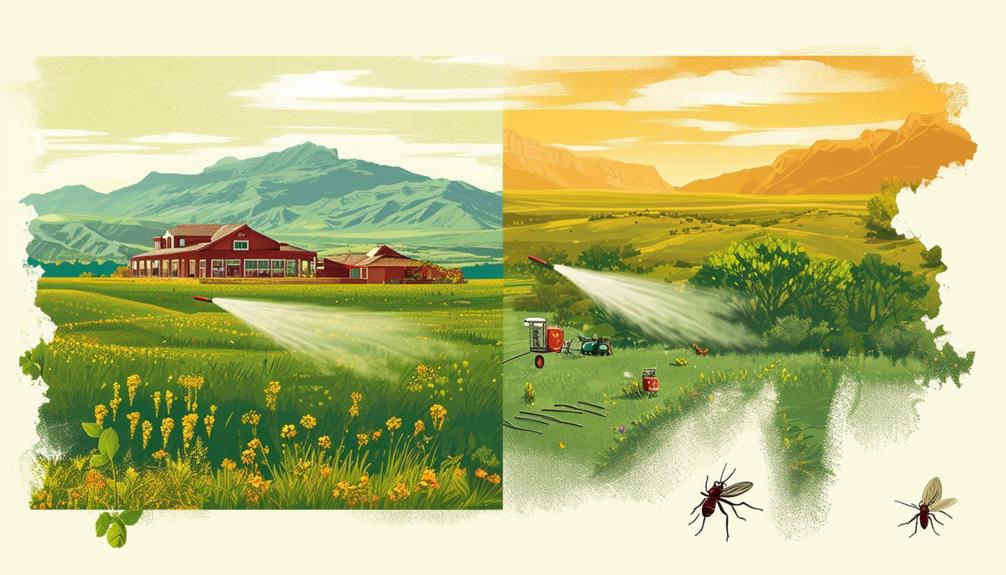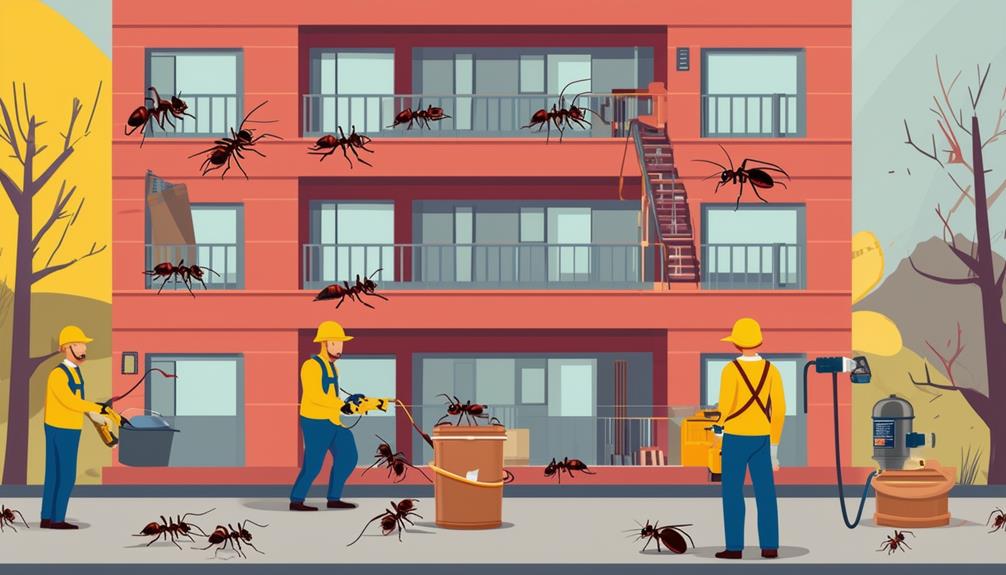When considering pest control methods in Utah, have you ever pondered the far-reaching consequences beyond just eliminating unwanted critters? The environmental impact of these methods goes beyond initial extermination, affecting ecosystems and wildlife. What measures are being taken to strike a balance between pest management and preserving Utah's natural environment? Stay tuned to uncover the intricate web of environmental implications intertwined with pest control practices in Utah.
Key Takeaways
- Chemical pesticides threaten Utah ecosystems by harming non-target species and disrupting natural balances.
- Runoff from pesticide applications contaminates Utah's water sources, impacting aquatic life.
- Pesticides in Utah contribute to biodiversity loss by harming beneficial species like pollinators.
- Integrated Pest Management in Utah combines sustainable pest control methods to reduce chemical pesticide use.
- Utah promotes sustainable pest control practices through community involvement, emphasizing IPM and biological control methods.
Impact of Chemical Pesticides on Ecosystem
Chemical pesticides present a significant threat to ecosystems due to their potential to harm non-target species, disrupt natural balances, and persist in the environment. In the domain of pest management, while these chemicals are effective at controlling pests that pose risks to public health and agriculture, their indiscriminate use can have severe consequences on the environment. The residues left behind by these pesticides can accumulate in soil and water sources, leading to contamination that affects various organisms within the ecosystem. This environmental impact extends beyond just the targeted pests, with implications for wildlife populations and even human health through the food chain.
The persistence of chemical pesticides in the environment underscores the necessity of adopting sustainable pest control methods. Understanding the broader repercussions of relying heavily on these chemicals is vital for maintaining ecosystem health and preserving biodiversity. Striking a balance between effective pest management and minimizing the environmental impact of chemical pesticides is paramount for long-term ecological sustainability.
Non-Target Organisms and Water Contamination
The potential harm to non-target organisms and water systems due to pesticide use in pest control highlights the critical importance of implementing sustainable practices in Utah. Pesticides, while effective against pests, pose significant risks to non-target organisms such as bees, birds, and aquatic life.
Runoff from pesticide applications can lead to water contamination, impacting both aquatic ecosystems and drinking water quality. The residues of these chemicals can bioaccumulate in aquatic organisms, causing long-term ecological disruptions. Additionally, pesticide drift during application increases the likelihood of affecting nearby water bodies, further exacerbating the risk of water contamination.
The pervasive nature of pesticides in the environment underscores the urgent need for more environmentally friendly pest control methods to mitigate the adverse effects on non-target organisms and water systems. Prioritizing sustainable pest control practices is essential to safeguarding the delicate balance of Utah's ecosystems and preserving water quality for both wildlife and human consumption.
Biodiversity Loss From Pest Control Methods
How much can pest control methods impact biodiversity in Utah?
Pesticide use in pest control has been linked to significant biodiversity loss in the region. The following factors contribute to this impact:
- Non-Target Species Harm: Pesticides used in pest control don't discriminate between target pests and beneficial non-target species, leading to unintended harm to organisms important for ecosystem health.
- Disruption of Ecosystems: Chemical sprays can disrupt the delicate balance of ecosystems by reducing the population of beneficial insects that play essential roles in various ecological processes.
- Pollinator Decline: Overuse of pesticides can result in the decline of pollinators like bees and butterflies, essential for the reproduction of flowering plants and the maintenance of plant diversity.
Biodiversity loss from pest control methods can have far-reaching consequences on the food chain and ecosystem stability. Implementing integrated pest management strategies is significant to mitigate these negative impacts and preserve Utah's biodiversity.
Integrated Pest Management Strategies in Utah
Integrated Pest Management (IPM) in Utah consistently focuses on sustainable pest control strategies that minimize environmental impact. By combining biological, cultural, physical, and chemical control methods, IPM effectively manages pests while reducing harm to the environment.
Utah's promotion of IPM reflects a commitment to decreasing reliance on chemical pesticides and safeguarding ecosystems. The state's IPM strategies not only address pest issues but also prioritize environmental preservation and the development of long-term pest control solutions.
Stakeholder collaboration within Utah plays a vital role in supporting the implementation of IPM practices, ensuring efficient and eco-friendly pest management statewide. Through the integration of various control methods and a holistic approach to pest management, Utah's IPM initiatives aim to strike a balance between effectively controlling pests and maintaining the ecological health of the state.
This all-encompassing strategy underscores Utah's dedication to sustainable pest control practices and environmental stewardship.
Promoting Sustainable Pest Control Practices
Emphasizing diverse strategies for sustainable pest control, Utah promotes practices that prioritize environmental health and long-term effectiveness. Integrated pest management (IPM) plays a vital role in achieving this goal by combining various methods to control pests sustainably.
The Utah Department of Agriculture advocates for the implementation of IPM to reduce reliance on harmful chemicals and minimize environmental impact. Additionally, biological control methods, such as introducing natural predators, are encouraged as eco-friendly alternatives to traditional pest control approaches.
Habitat modification is another key strategy promoted by the Utah Department of Agriculture, emphasizing actions like removing standing water to prevent mosquito breeding and controlling pest populations naturally.
Community participation is essential in promoting sustainable pest control practices, as it fosters awareness, encourages responsible actions, and contributes to the overall success of pest management programs. By focusing on long-term solutions and engaging the community, Utah aims to protect public health and the environment while effectively managing pest populations.
Environmental Benefits of Non-Toxic Alternatives
Non-toxic pest control methods play a crucial role in reducing harmful chemical residues in the environment. These environmentally friendly pest control practices offer numerous benefits, including supporting ecosystem balance and biodiversity through approaches like biological control. By minimizing risks to non-target species and habitats, non-toxic methods guarantee sustainable pest management without causing harm. Habitat modification is another effective strategy that promotes long-term pest control while preserving the environment. Integrated pest management strategies in Utah prioritize addressing pest issues in a manner that safeguards environmental quality.
| Benefits of Non-Toxic Alternatives |
|---|
| Reduces chemical residues in the environment |
| Supports ecosystem balance and biodiversity |
| Minimizes risks to non-target species and habitats |
| Promotes long-term pest management without harm |
Frequently Asked Questions
How Does Pest Control Affect the Environment?
When you consider wildlife preservation, soil contamination, and water pollution, pest control methods have significant environmental impacts. Understanding the consequences of these actions is essential for sustainable and eco-friendly practices.
How Are Pesticides and Insecticides Affecting Utah?
Pesticides and insecticides in Utah are impacting the environment. Soil contamination and wildlife exposure occur, leading to water pollution and biodiversity loss. Air quality is affected by pesticide drift, highlighting the need for sustainable pest control methods.
Is Pest Control Environmentally Friendly?
Hey, did you know that pest control can be environmentally friendly? By opting for eco-friendly alternatives like integrated pest management, you're choosing sustainable solutions that prioritize green practices. It's a win-win for you and the environment!
What Are the Consequences of Using Common Pest Control Methods?
When you use common pest control methods, you contribute to wildlife displacement, soil contamination, air pollution, water contamination, biodiversity loss, and ecosystem disruption. Consider sustainable options like integrated pest management to reduce these negative consequences.




